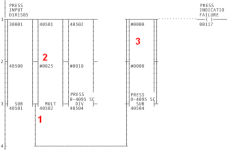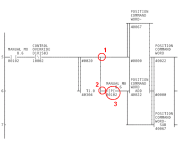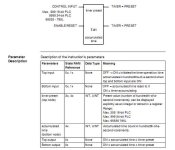Ken Roach
Lifetime Supporting Member + Moderator
This might be the first of many; I am learning Modicon ladder logic for a conversion project and I hope that Forum members can help me with some simple questions.
This rung scales an analog input and sets an alarm. I have three questions:
1. The lower output on a Modicon SUB instruction indicates that Value 1 is less than Value 2. So in this instruction, the branch is true if the analog input value in 30001 is less than the holding register value in 40500. Is this correct ?
2. Does this "#0025" represent a constant value ? Is it in Decimal or hex/octal/BCD ? In the A-B world, a "#" indicates an indirect or indexed value so I want to be sure about the Modicon syntax.
3. This SUB instruction appears to result in moving a zero to the holding register 40504. Is this SUB used instead of a "move" instruction to manually set 40504 to zero ?
3A. Do the three outputs "tied together" on this SUB instruction indicate that the output 00117 is true in every output case ?

This rung scales an analog input and sets an alarm. I have three questions:
1. The lower output on a Modicon SUB instruction indicates that Value 1 is less than Value 2. So in this instruction, the branch is true if the analog input value in 30001 is less than the holding register value in 40500. Is this correct ?
2. Does this "#0025" represent a constant value ? Is it in Decimal or hex/octal/BCD ? In the A-B world, a "#" indicates an indirect or indexed value so I want to be sure about the Modicon syntax.
3. This SUB instruction appears to result in moving a zero to the holding register 40504. Is this SUB used instead of a "move" instruction to manually set 40504 to zero ?
3A. Do the three outputs "tied together" on this SUB instruction indicate that the output 00117 is true in every output case ?






